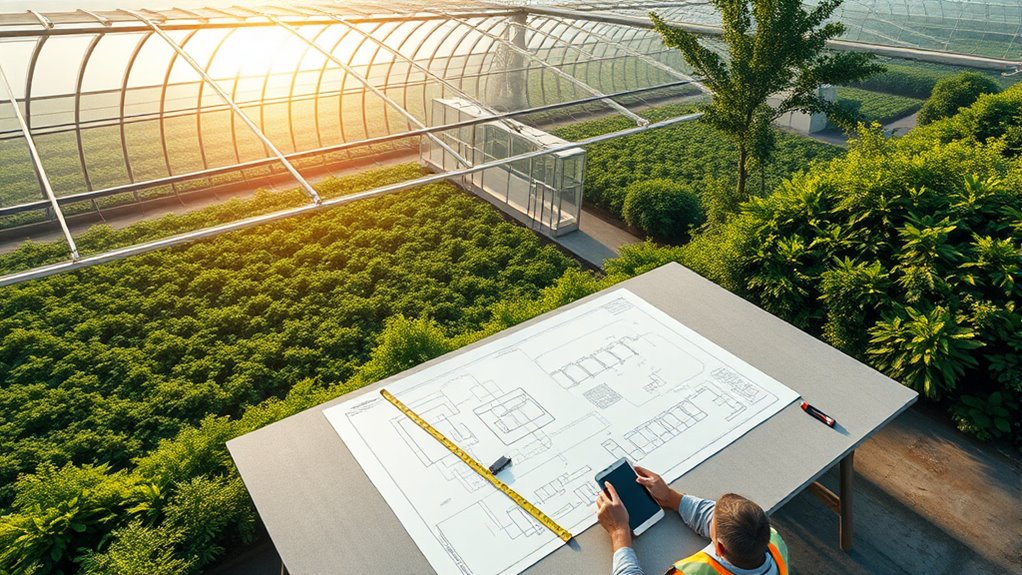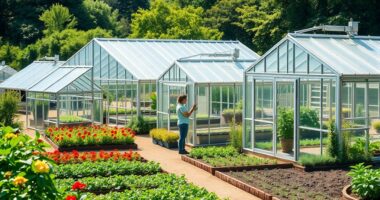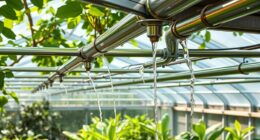To measure and plan for your greenhouse expansion, start by carefully taking precise dimensions of your current space, including length, width, and height. Assess what additional area or height you need, considering space for your plants and equipment. Next, evaluate how the new sections will connect and integrate with existing systems, including climate control and watering. Detailed measurements and a clear plan will help avoid surprises—keep going to discover all the steps for a successful expansion.
Key Takeaways
- Measure current greenhouse dimensions: length, width, height, and identify available space for expansion.
- Define expansion goals: additional area, height increase, or new sections, aligned with future needs.
- Evaluate physical constraints and integration factors, including zoning, access, and existing structures.
- Plan layout connections and system upgrades to ensure climate control, ventilation, and water management compatibility.
- Develop a detailed plan with measurements, budgeting, and step-by-step procedures for a smooth expansion process.

Expanding a greenhouse requires careful planning to guarantee your investment pays off. You need to assess your current setup, understand your goals, and anticipate future needs. One of the most critical steps in this process is accurately measuring your available space and determining how much expansion is feasible. Start by measuring the dimensions of your current greenhouse—length, width, and height—and then evaluate how much additional area you want to add. Consider the physical constraints of your property, such as zoning regulations, existing structures, and access points. This will help you decide whether a linear expansion, an increased height, or a new section altogether makes the most sense.
Once you’ve established the size, you’ll want to plan your layout carefully. Think about how the new space will integrate with your existing setup, especially regarding climate control and water management. Expanding your greenhouse means you’ll need to ensure that your climate control systems—heating, cooling, ventilation—are capable of maintaining ideal conditions across the larger area. This might involve upgrading fans, adding additional vents, or installing more precise temperature controls. Proper climate regulation is essential because uneven temperatures can stress plants, hinder growth, or cause disease.
Water management becomes even more critical as your greenhouse grows. You’ll need to evaluate your current irrigation system and determine if it can adequately serve the expanded space. Consider installing more drip lines, sprinklers, or a larger water reservoir to ensure consistent watering. Efficient water management not only conserves resources but also prevents issues like overwatering or drought stress in your plants. Incorporate rainwater harvesting or recycling systems if possible, which can help reduce costs and promote sustainability.
As you measure and plan, keep in mind that expansion isn’t just about adding space; it’s about creating a controlled environment that promotes healthy plant growth. You should also think about the airflow within the expanded area to prevent humidity buildup and reduce the risk of mold. Properly designed circulation systems will help maintain an even climate throughout the new space. It’s wise to consult with professionals or experienced growers to ensure your climate control and water management systems are scalable and efficient. Additionally, understanding greenhouse measurements is essential for precise planning and successful expansion.
Finally, create a detailed plan that includes all your measurements, system upgrades, and budget estimates. This will give you a clear roadmap for your expansion project, minimizing surprises and delays. With careful measurement and strategic planning, you’ll set your greenhouse up for successful growth—making sure your investment yields healthy plants and a thriving operation for years to come.
Frequently Asked Questions
What Are the Legal Requirements for Greenhouse Expansion?
You need to guarantee legal compliance by checking local zoning regulations before expanding your greenhouse. These regulations dictate where and how you can build, so review permits, building codes, and environmental policies. Obtain necessary approvals from local authorities, and stay updated on any changes that could affect your expansion plans. Meeting these legal requirements helps you avoid fines, delays, and potential legal issues, making your greenhouse expansion smooth and compliant.
How Does Climate Change Impact Greenhouse Planning?
Climate change acts like an unpredictable tide, shaping your greenhouse plans with rising temperatures and erratic weather. You must prioritize climate adaptation, designing structures with enhanced greenhouse resilience to withstand extreme conditions. By staying ahead of these changes, you guarantee your crops thrive despite shifting climates. Planning with flexibility and foresight helps your greenhouse weather the storm, safeguarding your investment and securing a stable future in an ever-changing world.
What Funding Options Are Available for Expansion Projects?
You can access various funding options for expansion projects through financial incentives like tax credits and rebates, which help reduce costs. Grant opportunities from government agencies and environmental organizations are also available, often aimed at promoting sustainable agriculture. Additionally, consider low-interest loans or crowdfunding campaigns to raise funds. Exploring these options can make your greenhouse expansion more affordable and aligned with eco-friendly practices.
How to Assess the Ecological Impact of Expanding?
You should assess the ecological impact of expanding by evaluating soil health and biodiversity preservation. Conduct soil tests to identify nutrient levels and contamination risks. Monitor local flora and fauna to ensure biodiversity isn’t threatened, and implement practices that protect native species. Additionally, consider potential runoff and pollution sources. This proactive approach helps you safeguard environmental integrity, ensuring sustainable growth and compliance with ecological standards.
What Are the Best Practices for Sustainable Greenhouse Growth?
To guarantee sustainable greenhouse growth, you should implement best practices like crop rotation to maintain soil health and reduce pest buildup, minimizing the need for chemical interventions. Adopt integrated pest management strategies that focus on natural pest controls and monitoring, preventing infestations before they escalate. Additionally, optimize resource use by upgrading to energy-efficient systems and recycling water, which supports environmental sustainability while boosting productivity.
Conclusion
By carefully measuring your current greenhouse and planning your expansion, you set yourself up for success. Did you know that greenhouse yields can increase by up to 30% with proper planning? This highlights the importance of precise measurements and strategic growth. Take the time to assess your space and needs, and you’ll maximize your investment, boost productivity, and guarantee sustainable expansion. Stay proactive, and your greenhouse will thrive beyond your expectations.









